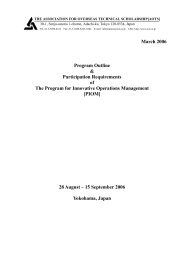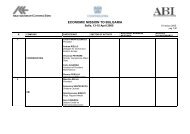Analysis of the Operation and Financial Condition of the Enterprise
Analysis of the Operation and Financial Condition of the Enterprise
Analysis of the Operation and Financial Condition of the Enterprise
You also want an ePaper? Increase the reach of your titles
YUMPU automatically turns print PDFs into web optimized ePapers that Google loves.
<strong>Analysis</strong> <strong>of</strong> <strong>the</strong> <strong>Operation</strong> <strong>and</strong> <strong>Financial</strong> <strong>Condition</strong> <strong>of</strong> <strong>the</strong> <strong>Enterprise</strong> competitiveness – <strong>the</strong> capacity <strong>of</strong> an enterprise to compete in a certain goodsmarket is in direct correlation with <strong>the</strong> competitiveness <strong>of</strong> <strong>the</strong> goods in question <strong>and</strong><strong>the</strong> economic methods <strong>of</strong> <strong>the</strong> enterprise operations, which, on its turn, affects <strong>the</strong>results <strong>of</strong> competition. The objective is to clarify those factors that influence <strong>the</strong>attitude <strong>of</strong> customers towards <strong>the</strong> enterprise <strong>and</strong> its output in <strong>the</strong> market, as well as<strong>the</strong> changes in <strong>the</strong> enterprise market share within a particular market. The followingbelongs to this set <strong>of</strong> measures: market share <strong>of</strong> <strong>the</strong> enterprise, quality <strong>of</strong> goods.Business performance analysis is an indispensable pre-condition forplanning. In order to perform substantiated planning <strong>of</strong> enterprise business activities it isnecessary to analyse in detail <strong>the</strong> implementation <strong>of</strong> <strong>the</strong> plan for <strong>the</strong> preceding period <strong>of</strong>operation. <strong>Analysis</strong> not only <strong>of</strong>fers <strong>the</strong> possibility <strong>of</strong> researching <strong>the</strong> success <strong>of</strong> activities <strong>of</strong>a certain enterprise, but also to compare <strong>the</strong>m to o<strong>the</strong>r same industry enterprises. This helpsto prepare optimal plans by ensuring high rates <strong>of</strong> operational growth.In order for <strong>the</strong> business activities to be efficient, entrepreneurs must be able toidentify what <strong>and</strong> in what amounts should be produced, what is <strong>the</strong> capital requirement <strong>and</strong>how to provide for it. Therefore, <strong>the</strong> extent <strong>of</strong> <strong>the</strong> production costs <strong>of</strong> <strong>the</strong> output must bespecified in order for <strong>the</strong> enterprise to gain sufficient pr<strong>of</strong>it; not only <strong>the</strong> strengths, but also<strong>the</strong> weaknesses <strong>of</strong> an enterprise must be assessed, that after having received moreattention, would ensure larger efficiency <strong>of</strong> enterprise operations. The systematic layout <strong>of</strong>business performance analysis is displayed in Figure 1.<strong>Enterprise</strong> performance analysis is <strong>the</strong> connecting link between accounting <strong>and</strong>decision-taking. During <strong>the</strong> process <strong>of</strong> analysis <strong>the</strong> information is being analyticallyprocessed – <strong>the</strong> existing results are compared to <strong>the</strong> results <strong>of</strong> <strong>the</strong> previous years as well aswith <strong>the</strong> forecasted. The enterprise results are likewise being compared to businessperformance analysis <strong>of</strong> competitors as well as with <strong>the</strong> industry average results. Theimpact <strong>of</strong> <strong>the</strong> various factors on <strong>the</strong> resulting values is being established; <strong>the</strong>re areinaccuracies, errors, unused opportunities <strong>and</strong> prospects disclosed.With <strong>the</strong> help <strong>of</strong> analysis problems are identified, <strong>the</strong>ir causes are established, <strong>the</strong>development is being projected <strong>and</strong> <strong>the</strong> possibilities for <strong>the</strong>ir prevention are beingdiscovered. Management decisions are developed <strong>and</strong> substantiated based on <strong>the</strong> resultsanalysis.<strong>Financial</strong> <strong>and</strong>managerial accounts<strong>Analysis</strong>Managementdecision-takingPlanning <strong>and</strong>forecastingOrganisation Control AdjustmentsInput at <strong>the</strong> start<strong>of</strong> <strong>the</strong> cycleCreation <strong>of</strong> value added(production, selling, investing)Output <strong>and</strong> services at <strong>the</strong>end <strong>of</strong> <strong>the</strong> cycle37
















